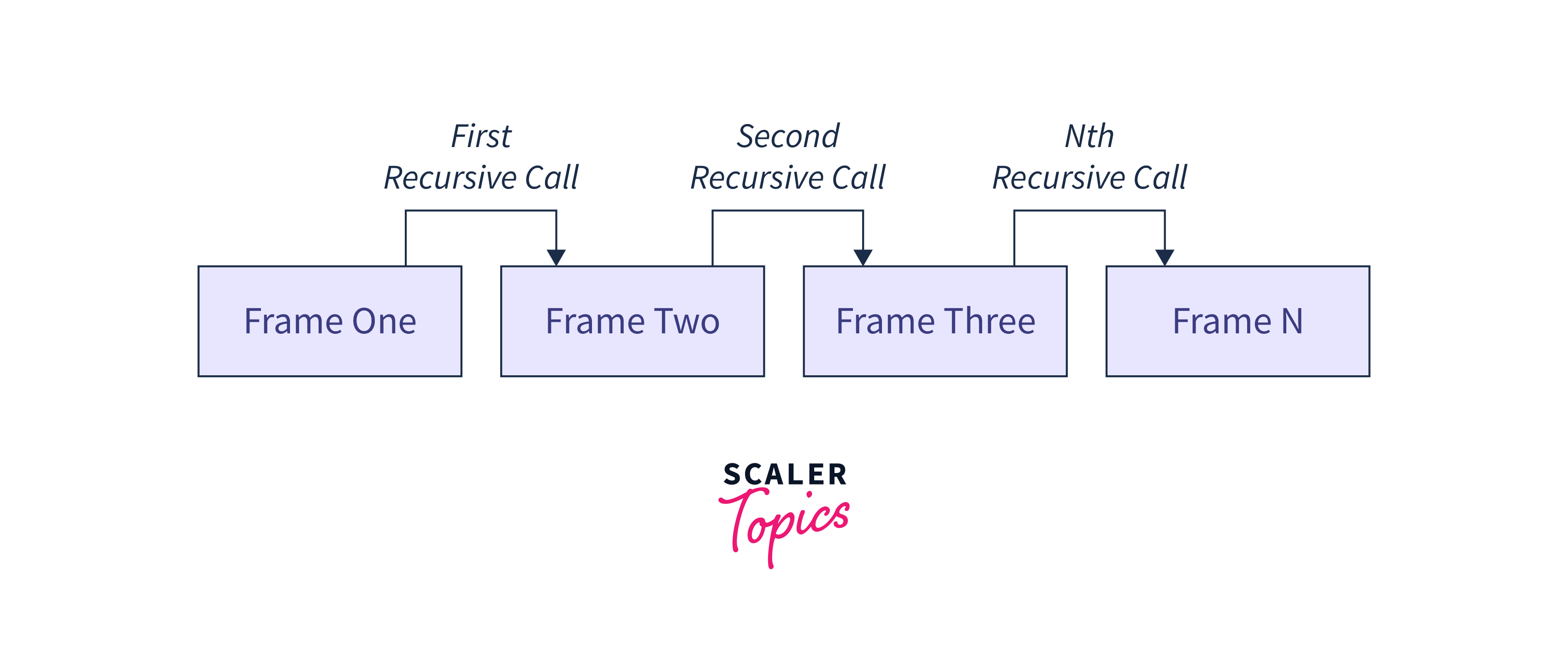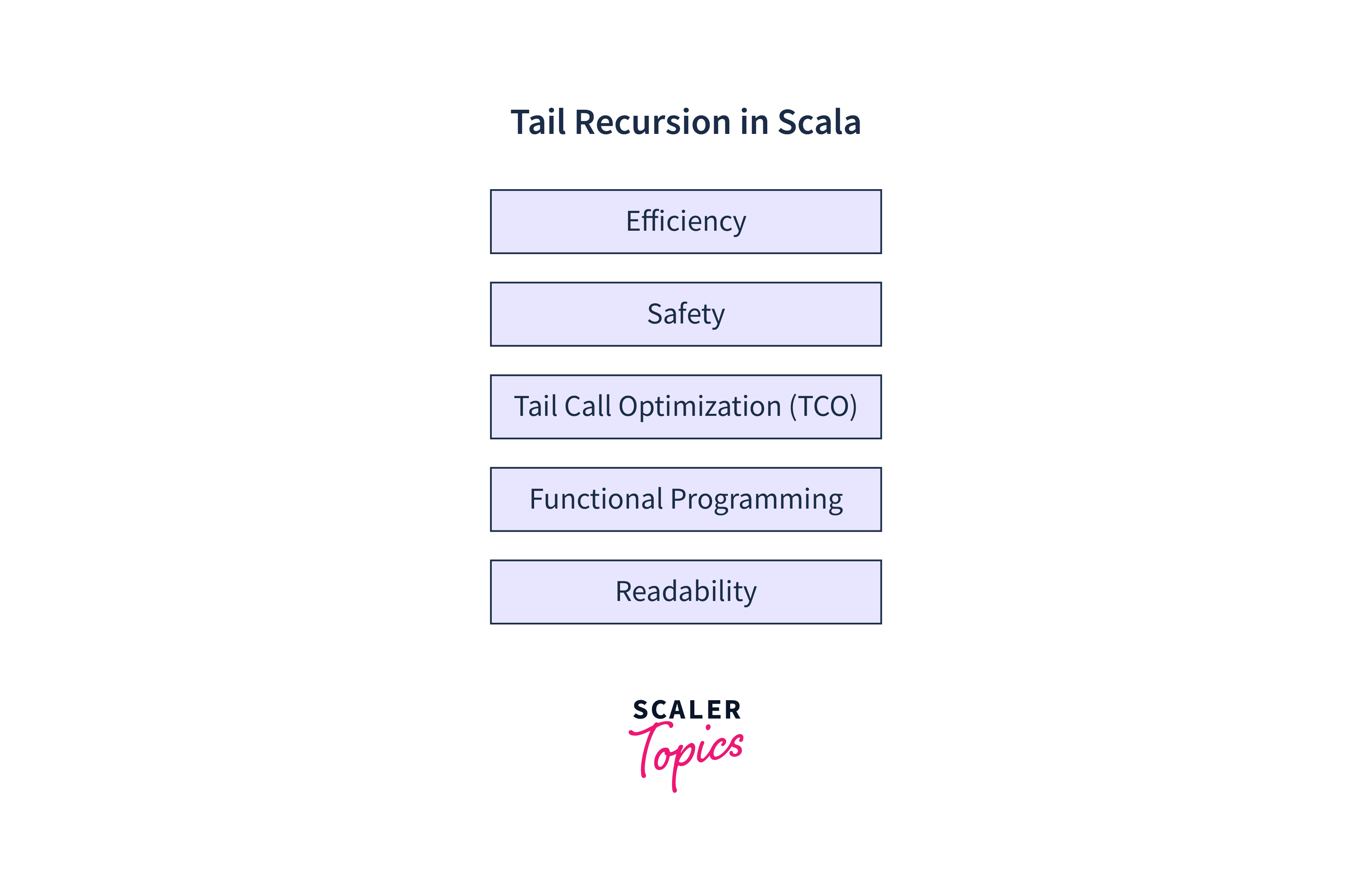Tail recursion in scala
Overview
Tail recursion is a special type of recursion in functional programming that allows a function to call itself as its last action, without adding to the call stack. This can help prevent stack overflow errors and is often more efficient than non-tail-recursive approaches. Scala, being a functional programming language, supports tail recursion optimization.
Introduction
Recursion is a fundamental concept in functional programming, allowing functions to solve complex problems by breaking them down into simpler subproblems. Tail recursion in Scala is a powerful technique for optimizing recursive functions. It allows a function to call itself as its last operation, enabling the Scala compiler to convert the recursion into an iterative process, reducing the risk of stack overflow errors and improving performance. By adhering to the principles of tail recursion, developers can write more efficient, readable, and memory-safe recursive code in Scala, making it a valuable tool for tackling complex problems in functional programming.
What Is Tail Recursion?
Recursion occurs when a function calls itself to solve a problem. However, if these recursive calls are not optimized, they can lead to a stack overflow error for deep recursion, as each function call consumes stack space. Tail recursion is a specific form of recursion that allows the recursive call to be the last operation performed in a function.

Scala provides a @tailrec annotation that can be used to indicate to the compiler that a function is intended to be tail-recursive. The compiler checks if the function indeed meets the requirements of tail recursion, and if it does, it optimizes the recursion. Tail recursion is a common technique used in functional programming to implement recursive algorithms efficiently and safely in Scala.
Functional Programming Principles
Tail recursion in Scala aligns closely with functional programming principles, and it's a powerful technique in the language. Scala is designed to support functional programming paradigms, and tail recursion is a key component of that alignment.
Here's how tail recursion in Scala corresponds to functional programming principles:
-
Pure Functions:
Functional programming emphasizes pure functions, which do not have side effects and return the same output for the same input. Tail-recursive functions in Scala often follow this principle by not modifying external state or variables within the function. They rely solely on their input parameters and provide deterministic results. -
Recursion:
Recursion is a core concept in functional programming, and Scala encourages its use. Tail recursion is a specific form of recursion where the recursive call is the last operation in the function. This is vital for optimization and preventing stack overflow errors, and it makes it easier for Scala's compiler to apply tail call optimization. -
Immutable Data:
Scala supports immutability, and tail-recursive functions in Scala typically work with immutable data. Rather than modifying existing data, they create new instances of data in each recursive call, which aligns with the functional programming principle of immutability. -
Higher-Order Functions:
Scala, being a hybrid language, combines both object-oriented and functional programming features. It excels in using higher-order functions, and tail recursion can be used in conjunction with higher-order functions, allowing functional programmers to work with more abstract and powerful abstractions. -
Tail Call Optimization (TCO):
Scala's compiler can apply tail call optimization to functions that use tail recursion. This optimization transforms the recursion into an iterative process, which prevents stack overflow errors and results in efficient memory usage. This is a crucial feature in functional programming languages like Scala.
The Importance of Tail Recursion
- Efficiency:
As mentioned earlier, tail-recursive functions can be optimized into iterative loops by the Scala compiler. This optimization results in constant stack space usage, making it suitable for deep recursion without causing stack overflow errors. - Readability:
Tail-recursive functions are often more straightforward and easier to understand than their non-tail-recursive counterparts. The base case and the recursive call are often the only components, reducing cognitive load. - Safety:
Since tail recursion is optimized into a loop, there's no risk of stack overflow errors. This provides an added layer of safety when working with recursive algorithms. - Functional Programming:
Tail recursion is aligned with the functional programming paradigm, making it a natural fit for Scala, a language known for its functional programming features.

Writing Tail-Recursive Functions in Scala
- Use Helper Functions:
If our primary function isn't tail-recursive, create a tail-recursive helper function within it. This helper function should carry additional parameters that accumulate intermediate results. - Apply the @tailrec Annotation:
Annotate the tail-recursive helper function with @tailrec. This informs the Scala compiler that we expect tail recursion optimization and raises an error if tail recursion isn't possible. - Ensure the Recursive Call is in the Tail Position:
The recursive call should be the last operation performed in the function, without any further computation. This ensures that the current function's stack frame can be reused for the next call.
Examples Of Tail Recursion
Let's look at an example of a tail-recursive function in Scala that calculates the sum of all integers from 1 to n.
Output:
Explanation:
- We define a function sumUpToN that takes an integer n as its parameter and returns the sum of integers from 1 to n.
- Inside the sumUpToN function, we define a tail-recursive helper function sumHelper. This function has two parameters: current to keep track of the current number we're adding, and accumulator to store the running sum.
- The @tailrec annotation is applied to the sumHelper function to indicate that we expect tail recursion optimization.
- In the sumHelper function, we check if current is greater than n. If it is, we return the accumulator, which holds the sum. This serves as the base case of the recursion.
- If current is not greater than n, we make a recursive call to sumHelper with an incremented current and an updated accumulator.
- The main function calls sumUpToN with the value 5 and prints the result.
The sumHelper function is tail-recursive because the recursive call is the last operation in the function. It doesn't perform any additional calculations after the recursive call. This unique property allows the Scala compiler to optimize the function through a process known as "tail call optimization" (TCO). TCO eliminates the need to create new stack frames for each recursive call, instead reusing the existing frame, effectively transforming the function into a loop-like structure.
This optimization prevents the excessive creation of stack frames and ensures constant memory usage, making it immune to stack overflow errors even with deep recursions. Not only does this approach enhance memory efficiency, but it also significantly improves performance, as it minimizes the overhead associated with managing the stack. As a result, the function can efficiently compute the sum of integers from 1 to n without consuming excessive memory, as demonstrated in the output
Difference Between Tail Recursion And Recursion
The key difference between tail recursion and regular (non-tail) recursion in Scala lies in how the recursive calls are handled by the Scala compiler and how they affect the program's execution. Here are the main distinctions:
-
Stack Usage:
- Regular Recursion:
In regular recursion, each recursive function call creates a new stack frame, which is added to the call stack. This means that the stack size increases with each recursive call. For deep recursion, this can lead to a stack overflow error, causing the program to crash. - Tail Recursion:
In tail recursion, the compiler optimizes the recursive calls by reusing the current function's stack frame for the next call. As a result, the stack size remains constant, regardless of how deep the recursion goes. This avoids stack overflow errors and makes tail-recursive functions more memory-efficient.
- Regular Recursion:
-
Order of Operations:
- Regular Recursion:
In regular recursion, the recursive call is not necessarily the last operation in the function. There may be additional computations or operations after the recursive call. This prevents the compiler from optimizing the recursion. - Tail Recursion:
In tail recursion, the recursive call is the last operation in the function. There are no pending operations or calculations after the recursive call. This characteristic allows the compiler to optimize the recursion.
- Regular Recursion:
-
Optimization:
- Regular Recursion:
The Scala compiler does not perform tail call optimization (TCO) on regular recursive functions. Therefore, the stack frames accumulate with each recursive call. - Tail Recursion:
The Scala compiler can perform tail call optimization on tail-recursive functions, effectively turning them into iterative processes. This optimization makes tail recursion more efficient in terms of memory usage and prevents stack overflow errors.
- Regular Recursion:
-
Use Cases:
- Regular Recursion:
Regular recursion is useful for many problems but is limited by stack space. It is suitable for cases where the depth of recursion is known to be small or can be controlled. - Tail Recursion:
Tail recursion is a preferred choice for implementing algorithms with deep recursion, such as tree traversal, factorial calculation, and list processing. It ensures that the function can handle large inputs without consuming excessive memory.
- Regular Recursion:
Conclusion
- Tail recursion in Scala is a recursive function where the recursive call is the last operation in the function, allowing the Scala compiler to optimize it into an iterative process.
- Tail recursion in Scala is important for optimizing memory usage and preventing stack overflow errors, enabling efficient handling of deep recursive operations.
- To implement tail recursion in Scala, we create a helper function with an accumulator to accumulate results, annotate it with @tailrec, and ensure that the recursive call is in the tail position, making it the last operation in the function.
- Tail recursion in Scala optimizes memory usage and prevents stack overflow by making the recursive call the last operation, while regular recursion doesn't optimize stack frames, potentially leading to stack overflow errors.
- Examples of tail recursion in Scala include calculating factorials and finding Fibonacci numbers efficiently by optimizing stack usage.
Learn More
If you're interested in delving deeper into scala and other functional programming concepts, here are some recommended references to help you expand your knowledge:
